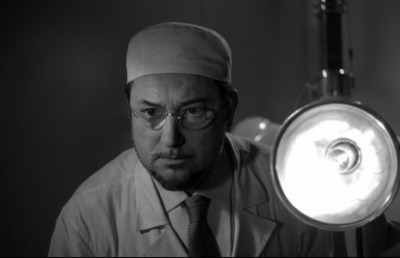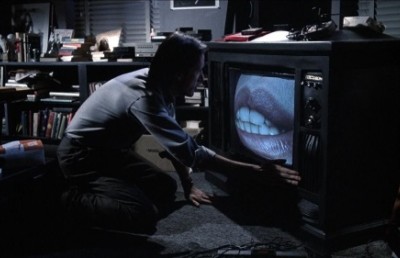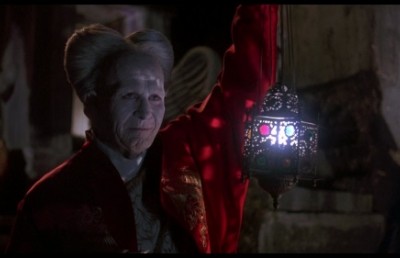The transcendence of the soul and the transcendence of flesh: a study in female subjectivity and on abject imagery of putrefaction in Argento’s Suspiria and Phenomena
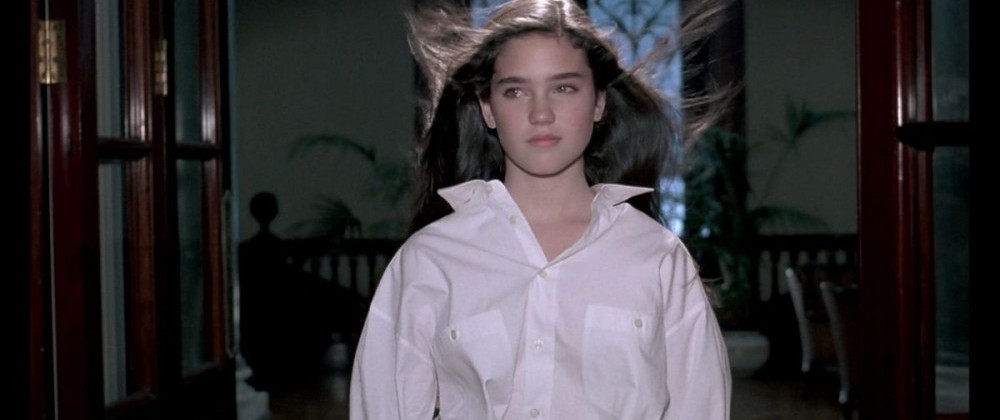
This essay is an investigation of one of the ways we can think about the moviegoer’s emotion of disgust and revulsion. To guide me throughout this brief study, I have chosen to examine the use of representations of abject imagery such as putrefaction and decomposition of organic matter and the “horror affect” they generate.
Abjection is a key concept which lies at the heart of semiotic theory. I will begin by briefly reviewing some of its basic elements, drawing upon the work of the philosopher and semiotician Julia Kristeva. Semiotics is the study of the process with which the significations are constructed. This process is called the semiosis. This semiosis takes as input a sign (or a signifier) and outputs another associated sign. The same process is repeated with the new signs until eventually, a signification is outputted. All kinds of perceptual data are considered as potential signs. Before entering the ‘symbolic order’ of significations, each sign, or combination of signs go through the stage of the chora semiotica. Kristeva claims that the experience associated with the putrefying corpse has no signification, meaning that it has not emerged out of the chora semiotica and is thus said to be abject.
The film excerpts on which I will conduct my analysis deals with various phenomenas associated with decomposition, such as biodegradation and the arrival of necrophagous and necrophilous insects. The putrefying process triggers a complex chain of natural events which constitute a rich and repulsive temporary microhabitat crawling with colourful beetles and flies who feast on dead meat, as larvae infest the humid fleshy niches of the carrion down to its smallest folds. In this essay, we will explore how elements from such a spectacle are exploited in Dario Argento’s Suspiria (1977) and Phenomena (1985).
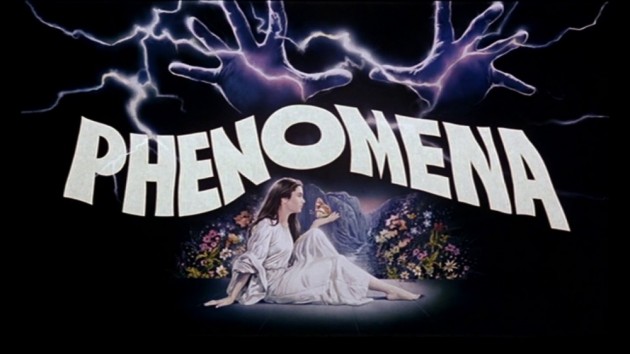
I would also like to introduce one of the main components of this essay which will provide us with a key framework through which we will come to understand the affective aims of putrid representations. All the films that I have selected for analysis feature a young female protagonist who has not yet reached sexual maturation. One goal of this essay is to explore the role which representations of putrefaction play in the development of the female protagonist’s subjectivity. The works of feminist film theorist from the 70s have been essential in our understanding of the representation of women, not only in popular cinema but also in various art forms throughout history. These representations aim to dehumanize women by suppressing all psychological dimensions of their characters and thus reducing them to mere bodies used to satisfy voyeuristic pleasures of male subjects – or of the “male gaze”. Given the undeniable predominance of these representations, there has been a clear absence of discourse on female desire and female subjectivity. Consequently this has profoundly affected women’s self-construction as sexual subjects.
Now this raises the question of what remains of the representability of female sexual subjectivity. If, following up on John Berger’s ideas, the representations of women which satisfy the gaze have extended to how they are supposed to see themselves – their identity being submitted to the dominance of the gaze (or to the Lacanian interior gaze) – , then not much of their original subjectivity would succeed in being externalized. They completely lack the language for its expression. Instead, they were given the language for its in expression. This is where the figure of the young female protagonist (Suzy in Suspiria, Jennifer in Phenomena) steps in. As they have not reached sexual maturity, the psychosexual energy associated with it, which is manifested supernaturally in our case, is creating serious breaches in the gaze’s repressive mechanism (the dance academy in Suspiria), thus compromising what is deemed representable within patriarchal ideologies.
However, the films mentioned in this essay do not aim to exhibit representations of women as subject of desire. Rather, they depict a journey towards sexual maturity which is horribly tormented by expectations of the male gaze. Given that the core repressive functions of the gaze are now endangered, our female protagonists have the ability to see through its mischievous conspiracies and maybe even catch a glimpse of its concealed putrid inner workings.
For the majority of the past centuries, there always has been great care in preserving the body and slowing down (ideally suppress) the process of putrefaction; knights were buried in their armor, perfumes were used to hide pestilent smells, small holes were carved at the bottom of coffins to facilitate the evacuation of putrid liquids… in short, endless types of practices were performed to disguise the unthinkable process of putrefaction. This was because the incorruptibility of the body signified the successful entrance of the soul in “the realm of the Lord”. As Marie-Pierre Krück points out, “transcendence and putrefaction are indissociable” and putrefaction was a fate destined to sinners and individuals who had succumbed to the carnal pleasures of life.
In Suspiria, Suzy (played by Jessica Harper), will experience a similar kind of bodily transcendence. She enters a dance academy where a well-established matriarchal order reign. This ballet environment is an almost perfect setting to depict how the mental and ideal male realm controls the bodily and physical female realm. The young ballerinas are taught to articulate their every single movements to perfectly fit “the immaculate image of the distanced feminine other” (Gough, 54). In other words, what is ultimately done here, is the resolution of castration anxiety by transforming the horrifying mutilated body of the mother (lacking the penis) – the abject female body – into the radiant and sensual feminine ideal. Hence, in Suspiria, we have to interpret the apparent matriarchal ballet environment as an intermediate repressive structure which is, in fact, governed by underlying male disembodied pleasures.
Near the beginning of film, Suzy, who was just struck by a puzzling vision as she made her way to her first ballet lesson, is now suddenly tired and dizzy. It is almost as if the expression of her repressed inner-body functions, associated with the development of the new sexual potential of her body, was resisting patriarchal subjective control. As her stern and forceful teacher forces her to dance like a puppet, to the calculated rhythm of gaze’s standards, she passes out and a bit of blood runs out of her nose. This could be linked to the ‘unclean’ feminine aspect of menstruation. This is first step towards the overflow/manifestation of abjection.

Suzy throws away the ‘blood wine’
She is then placed, without her consent, in a room of the institution’s dormitory where a doctor prescribes her wine, a symbol for her literally having to re-drink the blood that came out of her. He also gives her a sneaky injection and says “this will get you back into shape”. This could be interpreted as an attempt to “regulate her bodily functions internally, encouraging a ‘transcendence of flesh’ through submission to some higher authority” (Gough, 67). The ‘transcendence of flesh’ mentioned here, is the urge to retain an “absolute purity and ideal childlike, virginal impenetrability”, by suppressing any kind of excess of ‘obscene’ natural feminine aspects, either physical such as menstruation, or psychological, such as sexual desire. As Kristeva states, “bodily excess must be ‘lost’, in order for the body-as image to be symbolized.”
This is where the scene we are interested in occurs. As the ‘obscene’ manifestations of her inner – body kept being cast off beyond the limits of what the gaze can tolerate – limits of what signifies – , they are now going to try to retaliate with a more ignominious abjection. Soon after the doctor leaves, Suzy looks at herself in the mirror with worry. As she contemplates the doubtful image of her new regulated self, maggots start to fall on her hair. A disorienting camera movement reveals an inconceivable number of maggots on the ceiling, which have infested the whole academy. Everybody is sent downstairs and the authoritative dance teacher is sent to investigate this uncanny event. They discover that the source of the infestation comes from the attic, in a closed box filled with raw meat. As cover of the coffin is brutally opened by a supernatural force, we distinguish a wet phallic sausage amongst other pieces of meat swarming with larvae. The pleasures of the flesh, which had been carefully concealed and hidden in the attic – a symbol of the school’s unconscious – are now uncovering themselves as a decomposing nightmare.
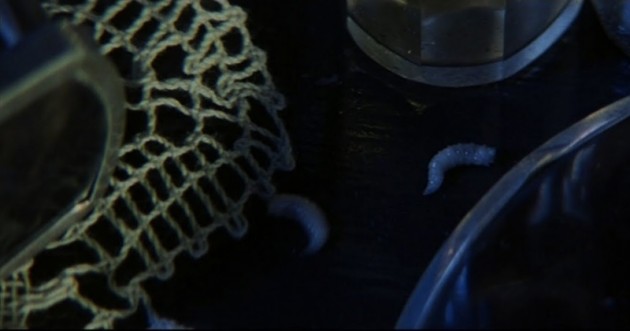
Maggots in Suspiria
The will to create a perfectly intelligible, idealized image of the feminine body, is in fact equivalent to the will to preserve and beautify the dead body. The ‘transcendence of flesh’ is also the ‘transcendence of the soul’. Consequently, within this context, the so-called ‘soul’, which must be blessed by the divine, is nothing more but the ‘disembodied immateriality’ of the gaze. Hence, one could speculate that the gaze strives for immortality, and for this to happen, death itself must yield to its disembodied pleasures – which is precisely what putrefaction prevents. This is why, near the end of the film, when Suzy, guided by the supernatural manifestations of her unconscious, finally manages to bypass the repressive control of the matriarchal order. She literally encounters an invisible entity. It is the ‘disembodied immateriality’ of the gaze itself, that had been hiding quietly behind the deceitful world of images that it had created. Nothing represents it, and nothing embodies or incarnates it. As Suzy catches a glimpse of its blinking outlines, she stabs it with a phallic spine. The entity turns into a dying corpse soaked in putrid liquid. The decomposing body reaches for Suzy’s face before falling on the ground. In its final agony, it attempts to seek comfort in the symbolic order – Suzy’s body – before crawling back to its inevitable fate, the chora semiotica.
In Phenomena, Jennifer (played by Jennifer Connelly) enters a very similar environment. All of the codes from Suspiria are used here again: a young girl in white virginal clothes joins a boarding school directed by matriarchs. Conversely, here, Jennifer has two peculiarities: she is a sleepwalker and she can telepathically communicate with insects. She is also presented as less naive than Suzy in Suspiria; she distrusts the matriarchal order from the very beginning and seems altogether not as childlike (she casually talks about her parent’s divorce). Additionally, unlike Suzy, her sleepwalking allows her to directly see one of the murder scenes. Given the contrast between the two films, one could argue that in Phenomena, Jennifer’s identity has not entirely been submitted to the dominance of the gaze. In Suspiria, the supernatural was “pychosexually representative of Suzy’s fantastically manifested unconscious”(Gough, 52). In Phenomena, Jennifer’s sleepwalking blurs the limits between conscious and unconscious. Hence, this could make her subjectivity slightly more sensitive to the morbid charms of necrophagous insects, for instance.
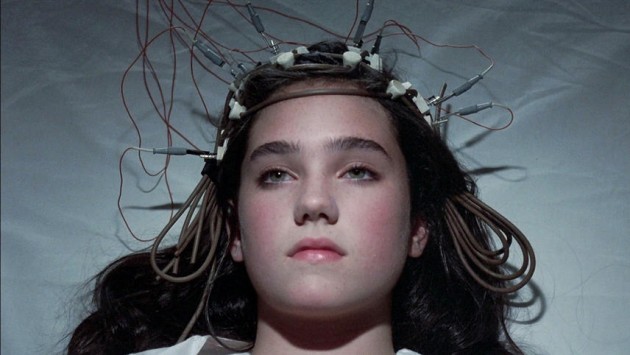
Jennifer Connelly in Phenomena
“What is this association between insects and the human soul?” asks the character of the entomologist, an expert on cadaverous fauna. In light of our previous interpretations, where the ‘transcendence of flesh’ was the same as the ‘transcendence of the soul’, we may implicitly suppose that the abject putrefying corpse poses a similar kind of threat as the abject female body of the mutilated mother. This is why Jennifer’s fondness for insects reflects the abjections of the ‘unclean’ feminine body. This makes Jennifer a bizarre student in the eyes of her classmates. She is considered a freak. Indeed, it is definitely not considered normal for a young girl to be friends with insects. In Phenomena, the male subjective control over her ideal image will be mediated by social pressure, instead of medical injections like in Suspiria. When Jennifer returns from the entomologists laboratory, she goes through a special kind of ‘slut shaming’. As all of the female students are making fun of her absurd telepathic bond with insects, Jennifer starts to cry and a cloud of necrophagous flies, which may represent the retaliation of her repressed abjections, surround the academy. This produces a similar nightmarish panic to the aforementioned maggot scene in Suspiria.
Phenomena has a very complex ending which, I confess, still puzzles me as much as it fascinates me. It deals with a different psychoanalytical paradigm which has something to do with mother-son pathological bonds that I will not explore here. There is a large amount of films that use various elements of putrefaction to exploit the weaknesses of the symbolic order. One clear example is from The Exorcist (1973) by William Friedkin in which Regan (Linda Blair), a per-adolescent girl is possessed by a demonic entity. Here, Regan’s material bodily transformations perfectly exemplify the corruption of its expected clean and proper ideal. Even if we do not witness the arrival of the whole necrophagous fauna, we can clearly see the decomposition of some parts of her body.
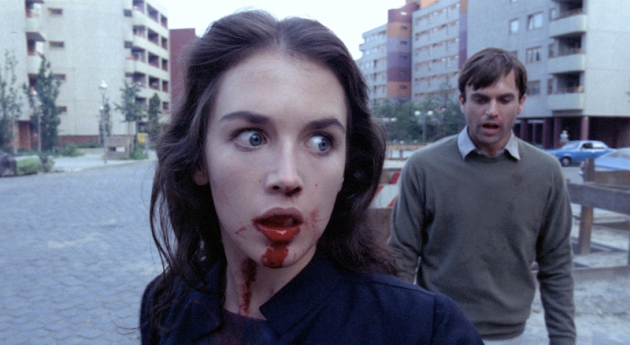
Possession
Another similar example is from the film Possession (1981) by Andrzej Zulawski. The setting of this film is different from the examples we have been discussing but it bears a lot of similarities in the way it treats the transformation of the female body. The narrative depicts a crisis within an heterosexual couple in which the main malfunctioning element is Anna’s (Isabelle Adjani) sexual dissatisfaction. The whole story is framed around the point of view of her husband and as the film progresses we come to discover his horrible realizations. Again here, the film attempts to depict the conflict between female sexual desire and expectations of the male gaze. In an iconic scene, Isabelle Adjani’s character completely loses her mind and the dye of her skin becomes pale and white as the one of corpses, an inconceivable amount of gruesome fluids come out of her, it as if the Lacanian interior gaze was trying to expel all of the putrid atrocities associated with her body. We later see her in a church looking up at the Jesus Christ, here again the scene emphasize the distance between the symbolic order and her abject situation.
Throughout the example of films we have seen, we might be tempted to conclude that the main affective aims of abject imagery is to attack the symbolic order and this may be the case for films like The Exorcist and Possession. Some other films, from Catherine Breillat for example, go even further and might attempt to “demonstrate that it is sham built on sexual repression and the sacrifice of the mother” (Creed, 30-42). But I would like to argue that films such as Suspiria and Phenomena try to awake a certain awareness of the female’s protagonist fragmented subjectivity, forcing the viewer to engage with a less traditional form of spectatorship and thus allowing him/her to recognize the ambiguity of dominant representational strategies.
Bibliography
Afeissa, Hicham-Stephane . “Esthétique de la charogne”, Dehors, 2019.
Creed, Barbara, “The Monstrous-Feminine”, London: Routledge, 1993
Freud, Sigmund. “Three essays on the theory of sexuality” Se, 7. 1905.
Gorton, Kristyn. “The Point Of View Of Shame Re-Viewing Female Desire In Catherine Breillat’s romance (1999) Anatomy Of Hell (2004)?”. Studies In European Cinema, vol 4, no. 2, 2007.
Gough, Charlotte. “The Ballerina Body-Horror: Spectatorship, Female Subjectivity and the Abject in Dario Argento’s Suspiria (1977)”, The Irish Journal of Gothic and Horror Studies 17, 2018.
Kristeva, Julia. “Pouvoirs de l’horreur : essai sur l’abjection”, Paris, Seuil, 1980.
Krück, Marie-Pierre. “Esthétique de la pourriture”, Études littéraires, 47 (1), 2016.
Lacan, Jacques. “Écrits 1”, Seuil, 1966.
Mulvey, Laura (Autumn 1975). “Visual pleasure and narrative cinema”. Screen. 16 (3): 6–18.



